“What’s your best price?”
You might think, now you’ll have to cut your price to something that they’ll agree to and close the deal somehow.
However, if you know the art of negotiation, you can still win the sale on your terms.
In this article, we will discuss tactics that can help you in various stages of sales negotiation. But before, know that:
Negotiation is not:
- Pestering the client with frequent phone calls, emails, or meeting requests.
- Pleading before the client to agree to the deal
- Promising what you can’t deliver
Then,
What is sales negotiation?
Negotiation is a discussion between two parties to come up with a mutually beneficial agreement.
In sales, this discussion is between buyers and sellers. Negotiation is an important sales skill as it is a part of most deals.
Let’s look at sales negotiation techniques to help you build rapport with the client.
7 Highly effective sales negotiation techniques
Master negotiators are very good communicators, active listeners, and strategic thinkers. They are empathetic but not emotional. Also, they are curious and know a lot about their clients.
These traits help top negotiators
- Understand the buyer’s needs
- Build trust
- Leave value on the table.
However, if we look closely, there are certain patterns in their conversations that can be learned.
- Mirroring
- Labeling
- Anchoring
- Giving options
- Sharing and reciprocating
- Quoting precisely
- Handling pricing objections
1. Mirroring
A key to successfully negotiating is to get as much information as you can from the other party.
For this, you’ll have to get them talking.
Mirroring is a simple technique in which you repeat 3-4 words from the last sentence of the speaker. It makes the other person feel you’re listening to them, and they open up more.
For example, if your client says, “…We’re a team of 40 people working remotely from across the globe.”
You can say, “A remote workforce of 40 members! That’s amazing.”
And let the client speak up more.

There is no restriction on the number of times you can mirror your client during a conversation. However, don’t throw your questions in between. The goal is to build a rapport and let them open up about all their concerns.
2. Labeling
“Contemplating an emotion reduces the negative and reinforces the positive.“
The labeling technique does just that. You label whatever your client seems to be feeling at that moment.
For example, if your client looks fussy, you can say, “It’s good to know you’re very particular about your requirements.”
However, be mindful of the words you choose. Using words like “demanding,” “picky,” etc., might backfire.
3. Anchoring
Anchoring means setting an initial price as a reference point.
It is important because it can influence the customer’s perception of the value and price of your product/service.
But who should make the first offer and how that offer will influence the negotiation is often debated.
According to Adam D. Galinsky,
When a seller makes the first offer, the final settlement price tends to be higher than when the buyer makes the first offer.
Via Harvard Business School Archives
Further, Galinsky favors an aggressive first offer. According to him,
By making an aggressive first offer and giving your opponent the opportunity to ‘extract’ concessions from you, you’ll not only get a better outcome, but you’ll also increase the other side’s satisfaction.
4. Giving options
People generally don’t want to be convinced into anything. Giving options helps buyers introspect and decide on the option they really want.
Depending on your product range, you can decide when to give options.
For example, in SaaS sales, you may not need to give options at the beginning of the discussion. It is generally required during the price negotiation phase.
When the client says, “Your product is more expensive than the one I’m currently using” or “It’s too expensive,” you can say,
“This is the best we can do in our current package. But here’s another option we have at a lower price with some adjustments.”

5. Sharing and reciprocating
Humans reciprocate concessions, threats, emotions, and even information.
That’s right. People open up more when they hear your secret.
Negotiators can use it to their advantage to get information about other party’s:
- Needs and desires
- Alternatives they are looking at
- Potential trade-offs
6. Quoting precisely
According to research by Petri Hukkanen and Matti Keloharju, precise bids yield better outcomes than round-number bids.
A precise quote indicates that the seller is well aware of his offering. In contrast, a round-number quote feels like just a ballpark figure.
So, next time, while negotiating with the buyer, quote a precise number like $1450 instead of a rounded-off figure like $1500 or $1400.
7. Handling pricing-related objections
The good news is if you’ve arrived at the price negotiation, you’re already very close to the deal.
You might wonder if there is a foolproof technique for price negotiation.
The truth is, it’s not that straightforward. Because sometimes the client may genuinely lack funds, while at other times, they may simply want to cut the deal at a lower price. So, you’ll need to use a combination of tactics to find the real issue and negotiate accordingly.
- Use mirroring If they complain, “Your price is too high,” mirror them in a concerning tone. Don’t justify your pricing at this point. Let them open up all their concerns. It will make them think that you are on their side and what you’ve proposed may be fine.
- Give options If the budget is an actual issue, give them options with some adjustments. But make sure you solve the main problem for which they came to you in the first place.
- Offer discounts If it doesn’t hurt your profit margins, you can offer additional discounts.
- Try unconventional methods You can barter or negotiate a longer contract duration if the client seems stern at pricing. For example, if your client runs an entertainment business, you can ask for free passes for your employees for their upcoming event.
Read more about handling sales objections.
Finally, know when to say NO.
There are two red flags to watch out for when pursuing a potential client. The first is if the client is too focused on negotiating price; this may mean they are not willing to pay what you are worth. The second is if the client does not fit into your usual use case, this may mean they will require too much customization outside of your normal scope of work.
Piyush Singhania, Team Manager – SMB Sales, LeadSquared
How to improve your negotiation skills
“If you have the will, you can surely develop the skill.“
Practice negotiation in your everyday life. Do a dry run before meeting your difficult client. Below are the tips to improve your negotiation skills.
- Learn as much as you can about your client’s needs, their organization’s culture, and their likes and dislikes.
- Be an active listener. The more you listen to your clients, the more you’ll understand them.
- Be empathetic. Whether it’s a budget issue or the client’s skepticism about your company/offering, be empathetic toward their concerns. Don’t be defensive. Resolve those concerns politely.
- Don’t be emotional. Detach your emotions from people, products, or the process of selling. Go with an open mind and hear them out. Don’t reciprocate the negative emotions of your clients.
- Be original. You should not look like a different person during negotiation than you were at the beginning. Copy the negotiation tactics, not the speech or tone of the experts. Develop your own style. 😊
- Be creative. Who knows, you can win their hearts by showing a creative approach to problem-solving. You can apply the following strategies to come up with creative solutions during negotiation.
How to negotiate creatively
The ideas discussed in this section will help you get your creative juices flowing.
1. Break the problem into smaller parts
Instead of focusing on the complete deal, you can break your client’s requirements into smaller chunks.
What may look like a big issue can be broken down into parts by asking a lot of questions and carefully listening to their answers.
2. Try different deal terms
This negotiation technique applies to cases where the deal gets stuck due to a lack of funds. Buyers and sellers can try unconventional terms to compensate for the pricing. For example,
- Barter each other’s products/services
- Ask for a longer contract duration
- Equity
3. Brainstorm ideas
You can invite your team members to brainstorm ideas to convince the buyer.
Sometimes, we are so stuck in our ways of doing things. A different perspective or views from people not associated with the ongoing negotiation could prove helpful.
4. Try mind-mapping
This technique helps you draw links between various aspects of the problem and trigger creative solutions.
Write down the problems for which you feel the deal has gotten stuck. Then think for a while and note down the words that come to your mind related to those problems. Now draw lines to connect the words that seem related.
5. Try flipping technique
In this technique, we try to solve a problem by turning it on its head.
For example, if your problem is to sell a premium product, think about ways to not sell that premium product. Then re-flip your ideas and see if they spark something creative.
In conclusion
Negotiation helps both the customers and sellers, be vocal about their needs and desires and come to an agreement.
I hope this compilation of sales negotiation techniques is helpful. Over time, you can refine your negotiation skills based on your experiences.
You can also go through the following resources and training materials to hone your sales negotiation skills.
- Sales Negotiation Training: Essential Negotiation Skills for Sales Professionals by Harvard Law School (Freemium)
- The art of negotiation by Chris Voss (via Masterclass @ $180 per year, allows access to all classes)
- Sales negotiation training by RAIN Group (corporate program, pricing upon request)
- Sales negotiation by Negotiation Experts
- Successful Negotiation: Essential Strategies and Skills by University of Michigan (via Coursera @ $40 per month)
FAQs
Article highlights
>> Sales negotiation techniques like mirroring, labeling, anchoring, handling objections, and more.
>> Tips to improve your negotiating skills
>> Strategies to think creatively during negotiations
What are the 5 stages of negotiation?
According to a Washington State University article, the five stages of negotiation are:
Investigation: It is an information gathering stage in which you also analyze your goals for the negotiation.
Determining your BATNA (Best Alternative to a Negotiated Agreement): Here, you analyze the list of alternatives that you might accept if the negotiation doesn’t flow as per your terms.
Presentation: At this stage, you present the facts that demonstrate your value.
Bargaining: It is a discussion phase where buyers and sellers negotiate deliverables and pricing.
Closure: This is the final stage, where the offer is either accepted or rejected.
What are the 3 basic approaches to negotiation?
According to MindEdge Learning, the three general approaches to negotiation are:
Integrative negotiation: When the negotiating parties share a prior relationship and want to come up with an agreement where everyone gets what they value most, this technique can be helpful. It focuses on identifying or creating additional values for both parties without sacrificing anything.
Distributive negotiation: It is used when both parties try to claim the benefit for themselves. It often leads to competitive interactions and the outcomes are short-term and transactional.
Mixed-motive negotiation: It comprises a mix of integrative and distributive negotiation tactics. It is generally used when the parties are not really sure about their compatibility.









